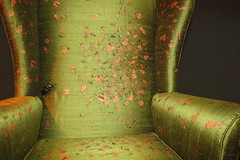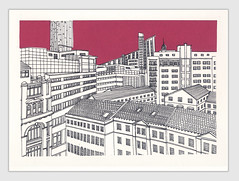The Absence of Nature
The printing, upholstering and final result of ‘The Absence of Nature’ chairs. The blue chair, entitled Chair (The Presence of Nature) Or, ‘Life’ is upholstered in a six-colour screenprinted fabric. The white chair, entitled Chair (The Absence of Nature) Or, ‘this should be an empty space on a plinth, though the plinth wouldn’t exist without nature either…’ is upholstered in a single colour screenprinted fabric.
The piece is meant to highlight the beauty, detail and intricacy of nature against the bland, colourless state of the alternative, exploring biodiversity and the loss of nature.
The fabric was developed during my AA2A residency at UCLan in Preston.
Plantlife Commission
Since earlier in the year, I’ve been working on a commission for County Hospital in Stafford. As part of a major ward refurbishment, I was asked to work with patients, staff and other stakeholders to create a ‘medicinal herbs’ themed piece of work for the new Elective Orthopaedics Ward.
We eventually decided on some large scale silhouettes of herbs with a watercolour texture for the eight-metre long corridor walls. These were printed onto vinyl and then cut out with a plotter so each herb was an individual piece of work. Patients and staff created some of the textures for the herbs alongside some smaller pieces that will be framed and hung in the waiting room. Everyone did some fantastic work – I’ll post some pictures of the framed pieces once they are up but in the meantime, here’s some of the wall vinyls and some work from the creative sessions. I’ve also included some of the original drawings for the herb silhouettes and the designs for two posters I’m screen printing that explain the symbolic meaning of the herbs featured in the artwork.
It’s all Bentley’s fault…
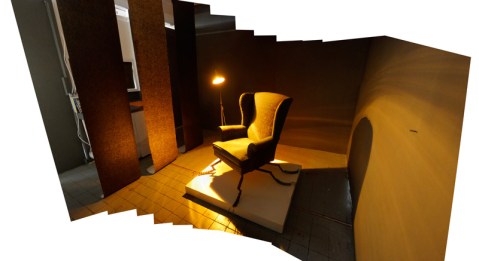
Following last year’s project for Bentley Library where I worked with local groups to create a community library chair, I’ve been itching to have a go at making/upholstering another one. So, for a recent exhibition at Hot Bed Press, I decided to create some screenprinted textiles for a new piece of work in the shape of a Parker Knoll armchair.
‘Infestation’ is upholstered in silk, hand screenprinted with hundreds of beetles which appear to be crawling out of the chair. Each piece of material features an individual design created from my drawings of beetles. There are about 100 different species of beetle in the surface design from the Javan Fiddle Beetle (Mormolyce phyllodes) to, my favourite, the Long-Necked Shining Fungus Beetle (Datelium wallacei) – you can’t beat that for a name. The chair also has it’s very own beetle legs, brilliantly made by Arbarus.
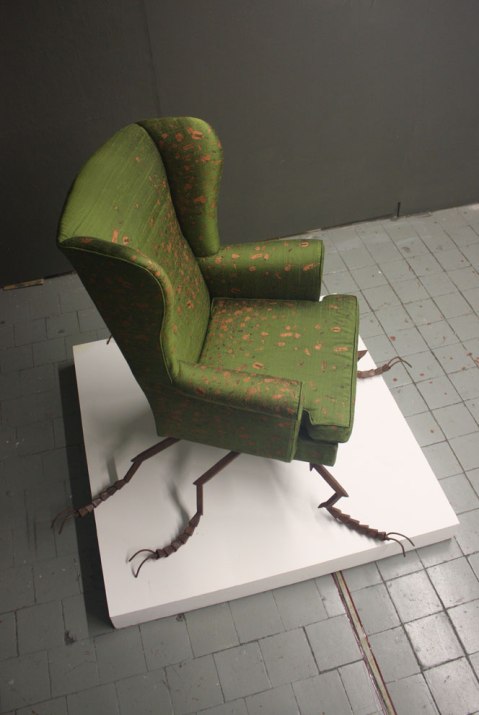
The work is part of an ongoing series in which I’ll be exploring chairs and similar products, questioning their form and usability (does a chair have to be functional to be a chair?) and reimagining the original design and finish to manipulate reaction and perception.
To create this installation piece I firstly used Photoshop to generate full-size artwork from scans of my beetle drawings, which I then turned into screenprints. I created individual screens for both the fill colour and the key layer (the final line). I’d pre-cut and labelled the individual pieces of silk for the upholstery so I could control which part of the pattern was on each part of the chair. Once the fabric was printed, I set about upholstering!
Nature Printing
 I’ve been printing leaves for about six years now and during that time I’ve been developing my technique, exploring different methods and constantly trying to improve the results to achieve what I want. My process currently involves inking each leaf individually and then printing from them, which means only one-off prints are achievable.
I’ve been printing leaves for about six years now and during that time I’ve been developing my technique, exploring different methods and constantly trying to improve the results to achieve what I want. My process currently involves inking each leaf individually and then printing from them, which means only one-off prints are achievable.
During recent research for an artist residency application, I came upon a technique that seems to recreate what I do and is a recognised form of printing which I had never heard of! So…. Nature Printing “the name given to the techniques of taking prints from natural objects such as leaves, flowers, or feathers, without the interposition of an artist who, interpreting the form of the original, will often distort it”. So writes Roderick Cave in his brilliant book ‘Impressions of Nature‘ which I now own and has lots of notes and scribbles over already.
 In reading this, and other information on nature printing, I came across a technique developed by Alois Auer at the Staatsdruckerei (the Austrian National Printing Office) and later, by Henry Bradbury. This technique was called electro-typing, which involves pressing the subject between a plate of steel and lead, then using the impression in the lead plate to create a copper plate in an electrolyte solution. This plate can then be inked as an intaglio plate and printed.
In reading this, and other information on nature printing, I came across a technique developed by Alois Auer at the Staatsdruckerei (the Austrian National Printing Office) and later, by Henry Bradbury. This technique was called electro-typing, which involves pressing the subject between a plate of steel and lead, then using the impression in the lead plate to create a copper plate in an electrolyte solution. This plate can then be inked as an intaglio plate and printed.
Henry Bradbury produced a book ‘The Ferns of Great Britain and Ireland’ which contained over 100 plates printed using the electro-typing process. They’re absolutely beautiful – you can feel the impressions of the ferns in the page and (for all you letterpress enthusiasts), the type too. The process is something that I’d like to consider researching further but it is going to involve a lot of head-scratching and deciphering of scientific language – not my strong point!
Drawing for screenprinting
 It seems like I’ve been permanently sat at my drawing board for the last month trying to get lots of drawings done for some new screen prints. These are to add to the highly detailed urban series I started in 2014 but this time I’ve created more of the large-scale drawings rather than just the small pieces. They’re approximately 500mm wide with variable heights.
It seems like I’ve been permanently sat at my drawing board for the last month trying to get lots of drawings done for some new screen prints. These are to add to the highly detailed urban series I started in 2014 but this time I’ve created more of the large-scale drawings rather than just the small pieces. They’re approximately 500mm wide with variable heights.
I’m really pleased with them but being bigger means that they take MUCH longer to draw – and the pressure is on not to get anything too wrong! Ho hum – I’m working my way through the Desert Island Discs back catalogue and have listened to Grayson Perry’s Reith Lectures again (which are just brilliant – I wish I was that eloquent!).
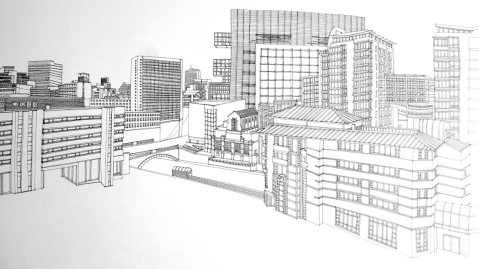 Here are some of the drawings finished and ready to be exposed onto screens ready for printing. I use the Staedtler Pigment Liner 0.05 and the Copic Multi Liner 0.03 for drawing. The Copic is the only one I have found in 0.03 and is brilliant as both nib and ink cartridge are easily replaceable (you get through a lot of nibs at this size). However, the Staedtler is my favourite – I haven’t found a better disposable pen in 0.05mm (I think I’ve tried them all!) and now buy boxes of 20 at a time.
Here are some of the drawings finished and ready to be exposed onto screens ready for printing. I use the Staedtler Pigment Liner 0.05 and the Copic Multi Liner 0.03 for drawing. The Copic is the only one I have found in 0.03 and is brilliant as both nib and ink cartridge are easily replaceable (you get through a lot of nibs at this size). However, the Staedtler is my favourite – I haven’t found a better disposable pen in 0.05mm (I think I’ve tried them all!) and now buy boxes of 20 at a time.
Elizabeth Gaskell’s House – Big Draw Workshop
Elizabeth Gaskell’s House in Manchester has just reopened after a £2.5 million refurbishment programme. Elizabeth Gaskell, famous for writing Cranford, Mary Barton, North & South, Ruth and Wives & Daughters amongst others lived in this house in Plymouth Grove from 1850 until her death in 1865.
As part of their half-term activities and for the 2014 Big Draw, the Elizabeth Gaskell House Team asked me to run a printmaking workshop based on the beautiful patterns and objects found around the restored rooms. In preparation I had great fun and felt very privileged to spend an afternoon photographing the House to create an exciting exploration game for the workshop.
I’ll post some pictures of the workshop when I get them – we had a professional photographer there and everything!
Hot Bed Press 20:20 is here again!
 I’ve just handed in my completed screenprint for the Hot Bed Press 2014 ’20:20 Print Exchange’. The 20:20 Print Exchange is a yearly event whereby printmakers are invited to produce a print measuring 20 x 20 cm in an edition of 25. You then submit your prints to Hot Bed Press and an army of volunteers (including me today!) sort them into boxes. Every entrant gets a box of prints back randomly chosen from the thousands available. Last year 585 artists took part producing 14,625 prints between them.
I’ve just handed in my completed screenprint for the Hot Bed Press 2014 ’20:20 Print Exchange’. The 20:20 Print Exchange is a yearly event whereby printmakers are invited to produce a print measuring 20 x 20 cm in an edition of 25. You then submit your prints to Hot Bed Press and an army of volunteers (including me today!) sort them into boxes. Every entrant gets a box of prints back randomly chosen from the thousands available. Last year 585 artists took part producing 14,625 prints between them.
My print this year uses some drawings taken from my Clarendon Square Shopping Centre workshops whereby young people drew their houses for a larger piece of artwork. I scanned these drawings into the computer, tweaked them (a little!) and created a five colour screenprint called ‘Houses of Hyde’.
I’m pleased with the result especially as I wanted to experiment with using overlays of colours to create further colours and it worked really well. I also continue to use ‘Frisk’ Film for the stencils rather than the more traditional paper / newsprint. Frisk Film doesn’t buckle and concertina on the screen so colour registration is much easier and more constant.
I’m going to give the school an artist’s proof of the final screenprint as a thankyou!
 I’m (well, I was when I wrote this two days ago) in Halifax (not that one, the one in Canada) waiting for my flight home to the UK after a month spent at Kingsbrae Residency for the Arts in St. Andrews, New Brunswick. Time spent in such a beautiful place has had a profound effect on my soul, whilst I’ve also had the rare chance to dedicate a complete month to my printmaking practice.
I’m (well, I was when I wrote this two days ago) in Halifax (not that one, the one in Canada) waiting for my flight home to the UK after a month spent at Kingsbrae Residency for the Arts in St. Andrews, New Brunswick. Time spent in such a beautiful place has had a profound effect on my soul, whilst I’ve also had the rare chance to dedicate a complete month to my printmaking practice.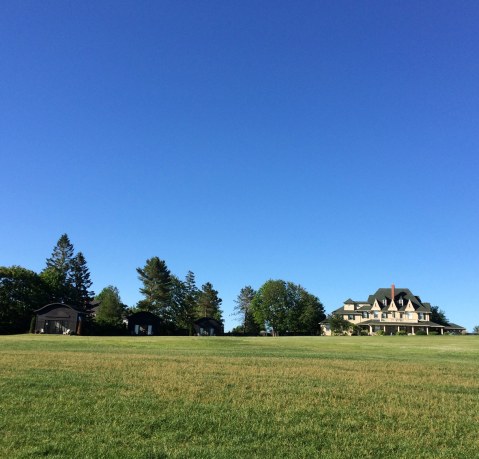 Alongside four other artists, I was selected from over 250 applicants to spend July here housed in a restored New Brunswick mansion with a dedicated studio on site and next to Kingsbrae Botanic Gardens, of which I had full access to, to develop my artwork.
Alongside four other artists, I was selected from over 250 applicants to spend July here housed in a restored New Brunswick mansion with a dedicated studio on site and next to Kingsbrae Botanic Gardens, of which I had full access to, to develop my artwork. Whilst spending a whole month solely creating monoprints has been intense and hard work, it has also allowed me to have a continuity to my practice which has meant my technique has improved, I’ve been able to experiment with different styles and have been re-inspired to ‘do’. I’ve also had the chance to connect with the St. Andrews art community, which is an extensive and engaged group of people.
Whilst spending a whole month solely creating monoprints has been intense and hard work, it has also allowed me to have a continuity to my practice which has meant my technique has improved, I’ve been able to experiment with different styles and have been re-inspired to ‘do’. I’ve also had the chance to connect with the St. Andrews art community, which is an extensive and engaged group of people. The best and most special part of the residency has been the chance to spend time with and get to know the four other artists – generous, talented, funny and wonderful – I have made four new friends for life – thankyou.
The best and most special part of the residency has been the chance to spend time with and get to know the four other artists – generous, talented, funny and wonderful – I have made four new friends for life – thankyou. Oh, and seeing over 20 humpback whales surrounding our boat, blowing air, tail-slapping and breaching was pretty amazing too…
Oh, and seeing over 20 humpback whales surrounding our boat, blowing air, tail-slapping and breaching was pretty amazing too…














































































